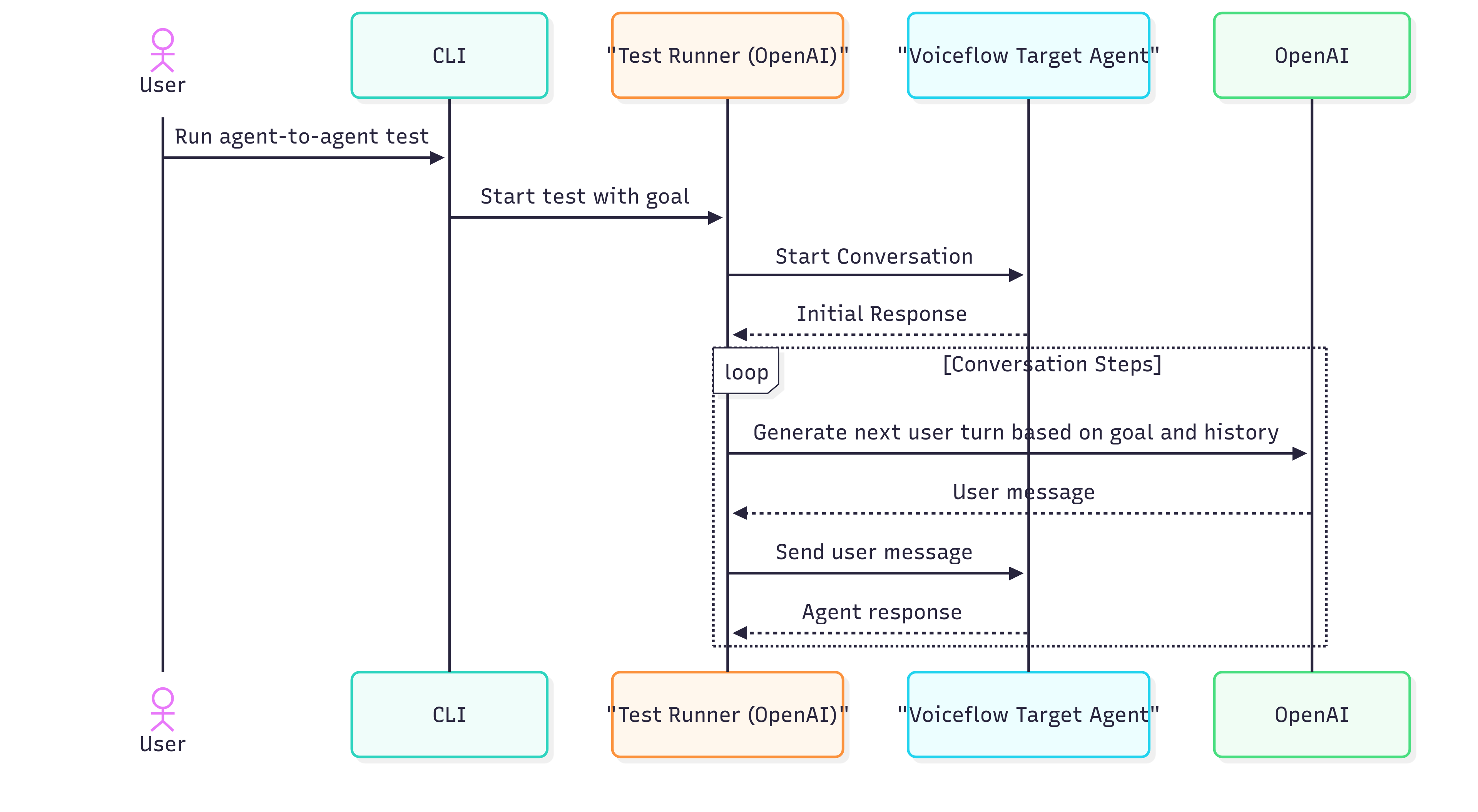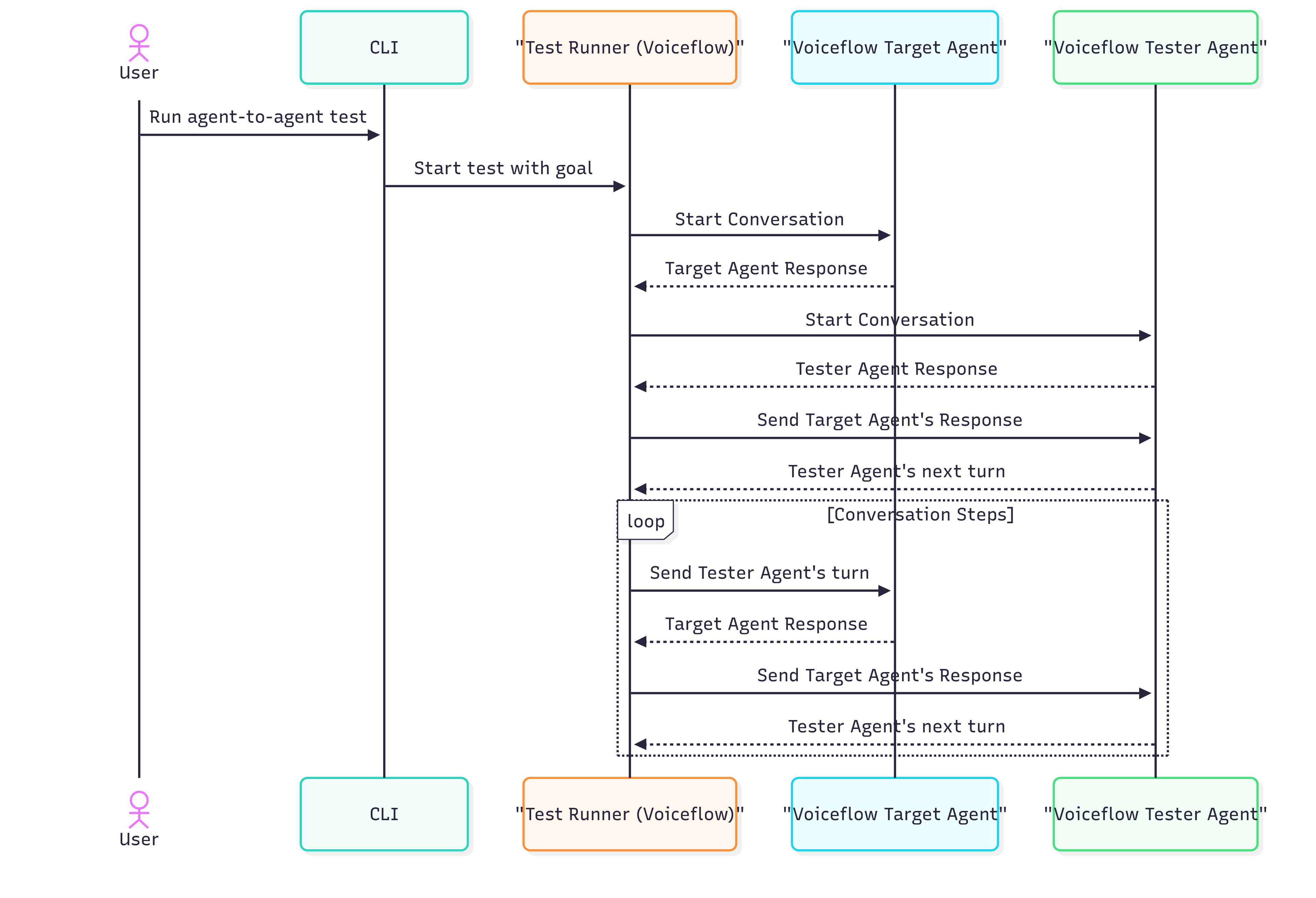Agent-to-Agent Tests Reference
Overview
Agent-to-Agent testing is a revolutionary approach to conversation testing that uses AI-powered agents to simulate realistic user interactions with your Voiceflow agent. Instead of predefined scripts, these tests use artificial intelligence to conduct natural, goal-oriented conversations.
There are two types of agent-to-agent testing available:
- OpenAI-Powered Testing: Uses OpenAI models (GPT-4, GPT-3.5, etc.) to simulate user behavior
- Voiceflow Agent Testing: Uses another Voiceflow agent as the tester to interact with your target agent
How It Works
OpenAI-Powered Testing Flow

- 🚀 Initialization: An AI agent is configured with a specific goal, persona, and user information
- 💬 Conversation Start: The AI agent launches a conversation with your Voiceflow agent
- 🤖 Dynamic Interaction: The AI agent responds naturally to your agent's messages, adapting to different conversation paths
- 📋 Information Requests: When your agent requests user information, the AI agent provides predefined data or generates realistic responses
- 🎯 Goal Tracking: The system continuously evaluates progress toward the specified goal
- ✅ Completion: The test succeeds when the goal is achieved or times out after maximum steps
Voiceflow Agent-to-Agent Testing Flow

- 🚀 Initialization: Two Voiceflow agents are configured - one as the tester and one as the target
- 💬 Conversation Start: Both agents are launched simultaneously
- 🤖 Agent Interaction: The tester agent conducts a conversation with your target agent
- 🎯 Goal Tracking: OpenAI evaluates whether the specified goal is achieved based on the conversation
- ✅ Completion: The test succeeds when the goal is achieved or times out after maximum steps
Key Advantages
- 🎭 Natural Conversations: AI agents respond like real users, not scripted robots
- 🔄 Multiple Paths: One test can explore various conversation flows automatically
- 📊 Comprehensive Coverage: Tests edge cases and unexpected user behaviors
- ⚡ Efficient: Replaces dozens of traditional tests with one adaptive test
- 🎯 Goal-Focused: Measures success based on outcomes, not exact responses
- 🤖 Dual Testing Modes: Choose between OpenAI-powered testing or Voiceflow agent testing based on your needs
Test Configuration
OpenAI-Powered Testing Structure
name: Customer Support Agent Test
description: Test agent's ability to resolve customer issues
agent:
goal: "Get help with a billing issue and update my account information"
persona: "A confused customer who received an unexpected charge on their account"
maxSteps: 20
userInformation:
- name: 'email'
value: '[email protected]'
- name: 'account_number'
value: 'ACC-123456'
- name: 'phone'
value: '555-0123'
openAIConfig:
model: gpt-4o
temperature: 0.7Voiceflow Agent-to-Agent Testing Structure
name: Customer Support Agent Test
description: Test using a Voiceflow agent as the tester
agent:
goal: "Get help with a billing issue and update account information"
maxSteps: 15
# OpenAI config is still used for goal evaluation
openAIConfig:
model: gpt-4o
temperature: 0.3
voiceflowAgentTesterConfig:
environmentName: "production" # Environment of the tester agent
apiKey: "VF.DM.your-tester-agent-api-key"
# Note: userInformation is not used with Voiceflow agent testing
# The tester agent should be pre-configured with any needed informationConfiguration Properties
goal (Required)
goal (Required)Defines what the AI agent is trying to accomplish. Be specific and measurable.
Examples:
"Complete a hotel booking for 2 guests for next weekend""Report a lost credit card and request a replacement""Get technical support for a software installation problem""Schedule a doctor's appointment for next month"
persona (OpenAI-Powered Testing Only)
persona (OpenAI-Powered Testing Only)Describes the character and context the AI agent should adopt during the conversation. This property is only used with OpenAI-powered testing and is ignored when using Voiceflow agent testing.
Examples:
"An elderly customer who is not tech-savvy and needs extra help""A busy professional who wants quick, efficient service""A frustrated customer whose previous issue wasn't resolved""A new user who doesn't understand the product yet"
maxSteps (Required)
maxSteps (Required)Maximum number of conversation turns before the test is considered failed. Consider your conversation complexity when setting this value.
Recommendations:
- Simple tasks: 5-10 steps
- Medium complexity: 10-20 steps
- Complex scenarios: 20-30 steps
userInformation (OpenAI-Powered Testing Testing Only)
userInformation (OpenAI-Powered Testing Testing Only)Predefined user data that the AI agent can provide when your Voiceflow agent requests personal information. This property is only used with OpenAI-powered testing.
For Voiceflow agent testing, any required user information should be pre-configured within the tester agent itself.
Common Information Types:
- Contact details:
email,phone,address - Account information:
account_number,customer_id,membership_id - Personal details:
name,first_name,last_name,date_of_birth - Transaction data:
order_number,transaction_id,amount
openAIConfig (Optional)
openAIConfig (Optional)Configures the OpenAI model and parameters used for the AI agent in this specific test. This configuration overrides any suite-level OpenAI settings.
For OpenAI Testing: Used to power the AI agent that conducts the conversation.
For Voiceflow Agent Testing: Used only for goal evaluation to determine if the test objective has been achieved.
Properties:
model: The OpenAI model to use (default:gpt-4o)temperature: Controls response randomness from 0.0 (deterministic) to 1.0 (creative) (default:0.7)
voiceflowAgentTesterConfig (Voiceflow Agent-to-Agent Testing Only)
voiceflowAgentTesterConfig (Voiceflow Agent-to-Agent Testing Only)Configures a Voiceflow agent to act as the tester instead of using OpenAI. When this configuration is present, the system will use agent-to-agent testing with two Voiceflow agents.
Properties:
environmentName: The environment name of the tester Voiceflow agent (e.g., "production", "development")apiKey: The API key for the tester Voiceflow agent (format:VF.DM.xxxxx.xxxxx)
Important Notes:
- When using Voiceflow agent testing, the
personaanduserInformationproperties are ignored - The tester agent should be pre-configured with appropriate conversation logic and any required user data
- OpenAI is still used for goal evaluation even when using Voiceflow agent testing
Example:
# OpenAI-powered testing configuration
agent:
goal: "Get technical support for a complex software issue"
persona: "A software developer who needs detailed technical assistance"
maxSteps: 15
openAIConfig:
model: gpt-4o
temperature: 0.3 # Lower temperature for more focused technical responses# Voiceflow agent-to-agent testing configuration
agent:
goal: "Complete a hotel booking for this weekend"
maxSteps: 12
openAIConfig:
model: gpt-4o
temperature: 0.3 # Used only for goal evaluation
voiceflowAgentTesterConfig:
environmentName: "production"
apiKey: "VF.DM.your-tester-agent-key"Choosing Between Testing Methods
OpenAI-Powered Testing
Best for:
- ✅ Flexible persona and behavior simulation
- ✅ Dynamic user information generation
- ✅ Complex reasoning and decision-making scenarios
- ✅ Testing edge cases and unexpected user behaviors
- ✅ Rapid prototyping and testing different user types
Requirements:
- OpenAI API key and sufficient quota
- Persona and user information configuration
Voiceflow Agent Testing
Best for:
- ✅ Consistent, reproducible test behavior
- ✅ Testing specific conversation flows designed in Voiceflow
- ✅ Using existing Voiceflow agents as test users
- ✅ Avoiding OpenAI API costs for conversation simulation
- ✅ Pre-configured user personas built in Voiceflow
Requirements:
- A separate Voiceflow agent configured as the tester
- API key for the tester agent
- OpenAI API key still needed for goal evaluation
OpenAI Model Configuration
Model Recommendations
gpt-4o: Best for complex reasoning and nuanced conversationsgpt-4o-mini: Good balance of performance and cost for most use casesgpt-3.5-turbo: Budget-friendly option for simpler interactions
Temperature Guidelines
0.0-0.3: Highly focused, deterministic responses (ideal for technical support)0.4-0.7: Balanced responses with some creativity (good for general conversations)0.8-1.0: More creative and varied responses (useful for casual interactions)
Suite-Level OpenAI Configuration
You can also configure OpenAI settings at the suite level, which applies to all agent tests unless overridden at the test level:
name: Customer Service Test Suite
description: Comprehensive customer service scenarios
environmentName: production
# Suite-level OpenAI configuration
openAIConfig:
model: gpt-4o-mini
temperature: 0.5
tests:
- id: billing_support
file: ./tests/billing_test.yaml
- id: technical_support
file: ./tests/technical_test.yaml # Can override with test-level config
- id: voiceflow_agent_test
file: ./tests/voiceflow_agent_test.yaml # Uses suite config for goal evaluationBest Practices
Writing Effective Goals
✅ Good Goals:
- Specific and measurable
- Achievable within the conversation scope
- Focused on user outcomes
❌ Avoid:
- Vague objectives
- Impossible tasks
- Testing internal system functions
Creating Realistic Personas (OpenAI Testing)
✅ Good Personas:
- Include emotional context
- Specify technical skill level
- Mention relevant background
❌ Avoid:
- Generic descriptions
- Inconsistent characteristics
- Unrealistic behaviors
Configuring Voiceflow Tester Agents
✅ Best Practices:
- Design the tester agent with clear conversation flows
- Include appropriate user information within the agent
- Test the tester agent independently before using in tests
- Use meaningful environment names and secure API keys
❌ Avoid:
- Using production agents directly as testers
- Hardcoding sensitive information in tester agents
- Creating overly complex tester agent flows
Setting Appropriate Step Limits
- Too Low: May timeout before completion
- Too High: May hide conversation inefficiencies
- Just Right: Allows natural completion with buffer for edge cases
Authentication Requirements
OpenAI Testing Requirements
OpenAI-powered agent tests require OpenAI API access for the AI agent functionality. Make sure to:
- Set up your OpenAI API key in your environment
- Configure authentication as described in the Authentication page
- Ensure sufficient API quota for test execution
Voiceflow Agent Testing Requirements
Voiceflow agent-to-agent tests require:
- Target Agent: API key for the agent being tested
- Tester Agent: API key for the agent acting as the tester (specified in
voiceflowAgentTesterConfig) - OpenAI API: Still required for goal evaluation functionality
- Environment Access: Ensure both agents are accessible in their respective environments
Monitoring and Debugging
Test Logs
Both testing methods provide detailed logs including:
OpenAI Testing Logs:
- AI agent's thought process and responses
- Conversation flow and decision points
- Goal achievement evaluation
- User information requests and responses
Voiceflow Agent Testing Logs:
- Interaction between tester and target agents
- Message exchange flow
- Goal achievement evaluation
- Agent response details
Common Issues
General Issues:
- Goal not achieved: Review if the goal is realistic and achievable
- Timeout errors: Consider increasing
maxStepsor simplifying the goal - Authentication errors: Verify API key configuration
OpenAI Testing Specific:
- Inconsistent behavior: AI responses may vary; focus on goal achievement rather than exact responses
- OpenAI API errors: Check API key and quota limits
Voiceflow Agent Testing Specific:
- Tester agent errors: Verify the tester agent is properly configured and accessible
- API key issues: Ensure both target and tester agent API keys are valid
- Environment mismatches: Verify environment names are correct for both agents
Updated 5 months ago